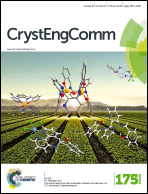Fine-tuning halogen bonding properties of diiodine through halogen–halogen charge transfer – extended [Ru(2,2′-bipyridine)(CO)2X2]·I2 systems (X = Cl, Br, I)†
Abstract
The current paper introduces the use of carbonyl containing ruthenium complexes, [Ru(bpy)(CO)2X2] (X = Cl, Br, I), as halogen bond acceptors for a I2 halogen bond donor. In all structures, the metal coordinated halogenido ligand acts as the actual halogen bond acceptor. Diiodine, I2, molecules are connected to the metal complexes through both ends of the molecule forming bridges between the complexes. Due to the charge transfer from Ru–X to I2, formation of the first Ru–X⋯I2 contact tends to generate a negative charge on I2 and redistribute the electron density anisotropically. If the initial Ru–X⋯IA–IB interaction causes a notable change in the electron density of I2, the increased negative charge accumulates on the second iodine, IB. The increased negative charge on IB reduces its ability to act as a halogen bond donor. With the [Ru(bpy)(CO)2Cl2] complex, the electron density of the I2 molecule remains isotropic and it acts as a symmetrical halogen bond donor for two metal complexes. With [Ru(bpy)(CO)2Br2] and [Ru(bpy)(CO)2I2], the Ru–X⋯IA–IB⋯X–Ru bridges are unsymmetrical with a stronger and shorter Ru–X⋯IA contact and a weaker and longer Ru–X⋯IB contact. In these cases, the negative charge is accumulated on the more weakly bonded IB atoms. QTAIM calculations were used to analyze the strength of the interactions and charge distribution in the metal complex and I2 molecule in detail. In accordance with the experimental data, the QTAIM analyses show that the charge difference between the two ends of the I2 molecule is increased in the order Ru–Cl⋯I2 < Ru–Br⋯I2 < Ru–I⋯I2.
![Graphical abstract: Fine-tuning halogen bonding properties of diiodine through halogen–halogen charge transfer – extended [Ru(2,2′-bipyridine)(CO)2X2]·I2 systems (X = Cl, Br, I)](/en/Image/Get?imageInfo.ImageType=GA&imageInfo.ImageIdentifier.ManuscriptID=C5CE02396C&imageInfo.ImageIdentifier.Year=2016)

 Please wait while we load your content...
Please wait while we load your content...